Advanced Fiber-Coupled Diode Laser Sensor for Calibration-Free 1f-WMS Determination of an Absorption Line Intensity
Abstract
:1. Introduction
2. Setup
3. Theoretical Background
3.1. 1f-WMS and Logarithmic Processing
3.2. Fitting of the 1f-WMS Spectra
4. Results and Discussions
4.1. Efficiency of the MPRR
4.2. Tolerance to the Nature of Photodetector
4.3. Tolerance to the Turbulences in the Optical Path
4.4. Fitting of the Experimental Spectra
4.5. Linearity
4.6. Effect of Non-Ideal LC
4.7. Wavelength Multiplexing with MPRR and Multifiber Bundle
5. Conclusions
Author Contributions
Funding
Conflicts of Interest
Appendix A
References
- Werle, P.; Slemr, F.; Maurer, K.; Kormann, R.; Mücke, R.; Jänker, B. Near- and mid-infrared laser-optical sensors for gas analysis. Opt. Lasers Eng. 2002, 37, 101–114. [Google Scholar] [CrossRef]
- Song, K.; Jung, E.C. Recent Developments in Modulation Spectroscopy for Trace Gas Detection Using Tunable Diode Lasers. Appl. Spectrosc. Rev. 2003, 38, 395–432. [Google Scholar] [CrossRef]
- Lackner, M. Tunable Diode Laser Absorption Spectroscopy (TDLAS) in the Process Industries—A Review. Rev. Chem. Eng. 2007, 23, 65–147. [Google Scholar] [CrossRef]
- Mantz, A.W.; Nadezhdinskii, A.I.; Sigrist, M.W.; Tittel, F.K. Special issue “7th International Conference on Tunable Diode Laser Spectroscopy. ” Appl. Phys. B 2010, 100, 231–232. [Google Scholar] [CrossRef]
- Hodgkinson, J.; Tatam, R.P. Optical gas sensing: A review. Meas. Sci. Technol. 2013, 24, 012004. [Google Scholar] [CrossRef] [Green Version]
- Rodin, A.; Klimchuk, A.; Nadezhdinskiy, A.; Churbanov, D.; Spiridonov, M. High resolution heterodyne spectroscopy of the atmospheric methane NIR absorption. Opt. Express 2014, 22, 13825. [Google Scholar] [CrossRef]
- Wang, F.; Jia, S.; Wang, Y.; Tang, Z. Recent Developments in Modulation Spectroscopy for Methane Detection Based on Tunable Diode Laser. Appl. Sci. 2019, 9, 2816. [Google Scholar] [CrossRef] [Green Version]
- Allen, M.G. Diode laser absorption sensors for gas-dynamic and combustion flows. Meas. Sci. Technol. 1998, 9, 545–562. [Google Scholar] [CrossRef] [PubMed] [Green Version]
- Bolshov, M.A.; Kuritsyn, Y.A.; Romanovskii, Y.V. Tunable diode laser spectroscopy as a technique for combustion diagnostics. Spectrochim. Acta Part B At. Spectrosc. 2015, 106, 45–66. [Google Scholar] [CrossRef]
- Goldenstein, C.S.; Spearrin, R.M.; Jeffries, J.B.; Hanson, R.K. Infrared laser-absorption sensing for combustion gases. Prog. Energy Combust. Sci. 2017, 60, 132–176. [Google Scholar] [CrossRef] [Green Version]
- Liu, C.; Xu, L. Laser absorption spectroscopy for combustion diagnosis in reactive flows: A review. Appl. Spectrosc. Rev. 2018, 1–44. [Google Scholar] [CrossRef] [Green Version]
- Furlong, E.R.; Mihalcea, R.M.; Webber, M.E.; Baer, D.S.; Hanson, R.K. Diode-Laser Sensors for Real-Time Control of Pulsed Combustion Systems. AIAA J. 1999, 37, 732–737. [Google Scholar] [CrossRef]
- Bolshov, M.A.; Kuritsyn, Y.A.; Liger, V.V.; Mironenko, V.R.; Nadezhdinskii, A.I.; Ponurovskii, Y.Y.; Leonov, S.B.; Yarantsev, D.A. Measurement of transient gas flow parameters by diode laser absorption spectroscopy. Quantum Electron. 2015, 45, 377–384. [Google Scholar] [CrossRef]
- Witzel, O.; Klein, A.; Meffert, C.; Schulz, C.; Kaiser, S.A.; Ebert, V. Calibration-free, high-speed, in-cylinder laser absorption sensor for cycle-resolved, absolute H2O measurements in a production IC engine. Proc. Combust. Inst. 2015, 35, 3653–3661. [Google Scholar] [CrossRef]
- Nadezhdinskii, A.I.; Ponurovskii, Y.Y. Diode Laser Spectrometer for High-Precision Measurements. Quantum Electron. 2019, 49, 613–622. [Google Scholar] [CrossRef]
- Reid, J.; Labrie, D. Second-harmonic detection with tunable diode lasers—Comparison of experiment and theory. Appl. Phys. B 1981, 26, 203–210. [Google Scholar] [CrossRef]
- Philippe, L.C.; Hanson, R.K. Laser diode wavelength-modulation spectroscopy for simultaneous measurement of temperature, pressure, and velocity in shock-heated oxygen flows. Appl. Opt. 1993, 32, 6090–6103. [Google Scholar] [CrossRef]
- Groll, H.; Schnürer-Patschan, C.; Kuritsyn, Y.A.; Niemax, K. Wavelength modulation diode laser atomic absorption spectrometry in analytical flames. Spectrochim. Acta Part B At. Spectrosc. 1994, 49, 1463–1472. [Google Scholar] [CrossRef]
- Linnerud, I.; Kaspersen, P.; Jaeger, T. Gas monitoring in the process industry using diode laser spectroscopy. Appl. Phys. B Lasers Opt. 1998, 67, 297–305. [Google Scholar] [CrossRef]
- Kluczynski, P.; Axner, O. Theoretical Description Based on Fourier Analysis of Wavelength-Modulation Spectrometry in Terms of Analytical and Background Signals. Appl. Opt. 1999, 38, 5803. [Google Scholar] [CrossRef] [PubMed]
- Kluczynski, P.; Gustafsson, J.; Lindberg, Å.M.; Axner, O. Wavelength modulation absorption spectrometry—An extensive scrutiny of the generation of signals. Spectrochim. Acta Part B At. Spectrosc. 2001, 56, 1277–1354. [Google Scholar] [CrossRef]
- Cassidy, D.T.; Reid, J. Atmospheric pressure monitoring of trace gases using tunable diode lasers. Appl. Opt. 1982, 21, 1185. [Google Scholar] [CrossRef]
- Duffin, K.; McGettrick, A.J.; Johnstone, W.; Stewart, G.; Moodie, D.G. Tunable Diode-Laser Spectroscopy with wavelength modulation: A calibration-free approach to the recovery of absolute gas absorption line shapes. J. Light. Technol. 2007, 25, 3114–3125. [Google Scholar] [CrossRef]
- Rieker, G.B.; Jeffries, J.B.; Hanson, R.K. Calibration-free wavelength-modulation spectroscopy for measurements of gas temperature and concentration in harsh environments. Appl. Opt. 2009, 48, 5546–5560. [Google Scholar] [CrossRef]
- Lan, L.J.; Ding, Y.J.; Peng, Z.M.; Du, Y.J.; Liu, Y.F. Calibration-free wavelength modulation for gas sensing in tunable diode laser absorption spectroscopy. Appl. Phys. B 2014, 117, 1211–1219. [Google Scholar] [CrossRef]
- Goldenstein, C.S.; Strand, C.L.; Schultz, I.a.; Sun, K.; Jeffries, J.B.; Hanson, R.K. Fitting of calibration-free scanned-wavelength-modulation spectroscopy spectra for determination of gas properties and absorption lineshapes. Appl. Opt. 2014, 53, 356–367. [Google Scholar] [CrossRef]
- Upadhyay, A.; Lengden, M.; Wilson, D.; Humphries, G.S.; Crayford, A.P.; Pugh, D.G.; Johnson, M.P.; Stewart, G.; Johnstone, W. A New RAM Normalized 1f-WMS Technique for the Measurement of Gas Parameters in Harsh Environments and a Comparison With2f/1f. IEEE Photonics J. 2018, 10, 1–11. [Google Scholar] [CrossRef]
- Ruxton, K.; Chakraborty, A.L.; Johnstone, W.; Lengden, M.; Stewart, G.; Duffin, K. Tunable Diode Laser Spectroscopy with Wavelength Modulation: Elimination of Residual Amplitude Modulation in a Phasor Decomposition Approach. Sens. Actuators B Chem. 2010, 150, 367–375. [Google Scholar] [CrossRef]
- Peng, W.Y.; Strand, C.L.; Hanson, R.K. Analysis of Laser Absorption Gas Sensors Employing Scanned-Wavelength Modulation Spectroscopy with 1f-Phase Detection. Appl. Phys. B Lasers Opt. 2020, 126, 1–23. [Google Scholar] [CrossRef]
- Liger, V.V.; Kuritsyn, Y.A.; Krivtsun, V.M.; Snegirev, E.P.; Kononov, A.N. Measurement of the absorption with a diode laser characterised by a detection threshold governed by the shot noise of its radiation. Quantum Electron. 1997, 27, 360–365. [Google Scholar] [CrossRef]
- Liger, V.; Zybin, A.; Kuritsyn, Y.; Niemax, K. Diode-Laser Atomic-Absorption Spectrometry by the Double-Beam—Double-Modulation Technique. Spectrochim. Acta Part B At. Spectrosc. 1997, 52, 1125–1138. [Google Scholar] [CrossRef]
- Zybin, A.V.; Liger, V.V.; Kuritsyn, Y.A. Dynamic Range Improvement and Background Correction in Diode Laser Atomic Absorption Spectrometry. Spectrochim. Acta Part B At. Spectrosc. 1999, 54, 613–619. [Google Scholar] [CrossRef]
- Wang, Y.; Cai, H.; Geng, J.; Fang, Z. Logarithmic Conversion of Absorption Detection in Wavelength Modulation Spectroscopy with a Current-Modulated Diode Laser. Appl. Opt. 2009, 48, 4068. [Google Scholar] [CrossRef]
- Cong, M.; Sun, D. Detection of Ammonia Using Logarithmic-Transformed Wavelength Modulation Spectrum. IOP Conf. Ser. Mater. Sci. Eng. 2018, 381. [Google Scholar] [CrossRef]
- Bolshov, M.A.; Kuritsyn, Y.A.; Liger, V.V.; Mironenko, V.R.; Leonov, S.B.; Yarantsev, D.A. Measurements of the temperature and water vapor concentration in a hot zone by tunable diode laser absorption spectrometry. Appl. Phys. B 2010, 100, 397–407. [Google Scholar] [CrossRef]
- Mironenko, V.R.; Kuritsyn, Y.A.; Liger, V.V.; Bolshov, M.A. Data Processing Algorithm for Diagnostics of Combustion Using Diode Laser Absorption Spectrometry. Appl. Spectrosc. 2018, 72, 199–208. [Google Scholar] [CrossRef]
- Li, J.; Yu, Z.; Du, Z.; Ji, Y.; Liu, C. Standoff Chemical Detection Using Laser Absorption Spectroscopy: A Review. Remote Sens. 2020, 12, 2771. [Google Scholar] [CrossRef]
- Wang, Z.; Sanders, S.T. Toward single-ended absorption spectroscopy probes based on backscattering from rough surfaces: H2O vapor measurements near 1350 nm. Appl. Phys. B 2015, 121, 187–192. [Google Scholar] [CrossRef]
- Smith, C.H.; Goldenstein, C.S.; Hanson, R.K. A scanned-wavelength-modulation absorption-spectroscopy sensor for temperature and H2O in low-pressure flames. Meas. Sci. Technol. 2014, 25, 115501. [Google Scholar] [CrossRef]
- Dubinsky, I.; Rybak, K.; Steinfeld, J.I.; Field, R.W. Frequency-modulation-enhanced remote sensing. Appl. Phys. B Lasers Opt. 1998, 67, 481–492. [Google Scholar] [CrossRef]
- Wainner, R.T.; Green, B.D.; Allen, M.G.; White, M.A.; Stafford-Evans, J.; Naper, R. Handheld, battery-powered near-IR TDL sensor for stand-off detection of gas and vapor plumes. Appl. Phys. B Lasers Opt. 2002, 75, 249–254. [Google Scholar] [CrossRef]
- Goldenstein, C.S.; Mitchell Spearrin, R.; Hanson, R.K. Fiber-coupled diode-laser sensors for calibration-free stand-off measurements of gas temperature, pressure, and composition. Appl. Opt. 2016, 55, 479. [Google Scholar] [CrossRef]
- Liger, V.V.; Mironenko, V.R.; Kuritsyn, Y.A.; Bolshov, M.A. Diagnostics of Hot Zones by Absorption Spectroscopy with Diode Lasers (Review). Opt. Spectrosc. 2019, 127, 49–60. [Google Scholar] [CrossRef]
- Klein, A.; Witzel, O.; Ebert, V. Rapid, Time-Division Multiplexed, Direct Absorption- and Wavelength Modulation-Spectroscopy. Sensors 2014, 14, 21497–21513. [Google Scholar] [CrossRef] [Green Version]
- Sur, R.; Sun, K.; Jeffries, J.B.; Socha, J.G.; Hanson, R.K. Scanned-wavelength-modulation-spectroscopy sensor for CO, CO2, CH4 and H2O in a high-pressure engineering-scale transport-reactor coal gasifier. Fuel 2015, 150, 102–111. [Google Scholar] [CrossRef] [Green Version]
- Wei, W.; Peng, W.Y.; Wang, Y.; Shao, J.; Strand, C.L.; Hanson, R.K. Two-color frequency-multiplexed IMS technique for gas thermometry at elevated pressures. Appl. Phys. B 2020, 126, 51. [Google Scholar] [CrossRef]
- Liu, J.T.C.; Rieker, G.B.; Jeffries, J.B.; Gruber, M.R.; Carter, C.D.; Mathur, T.; Hanson, R.K. Near-infrared diode laser absorption diagnostic for temperature and water vapor in a scramjet combustor. Appl. Opt. 2005, 44, 6701–6711. [Google Scholar] [CrossRef]
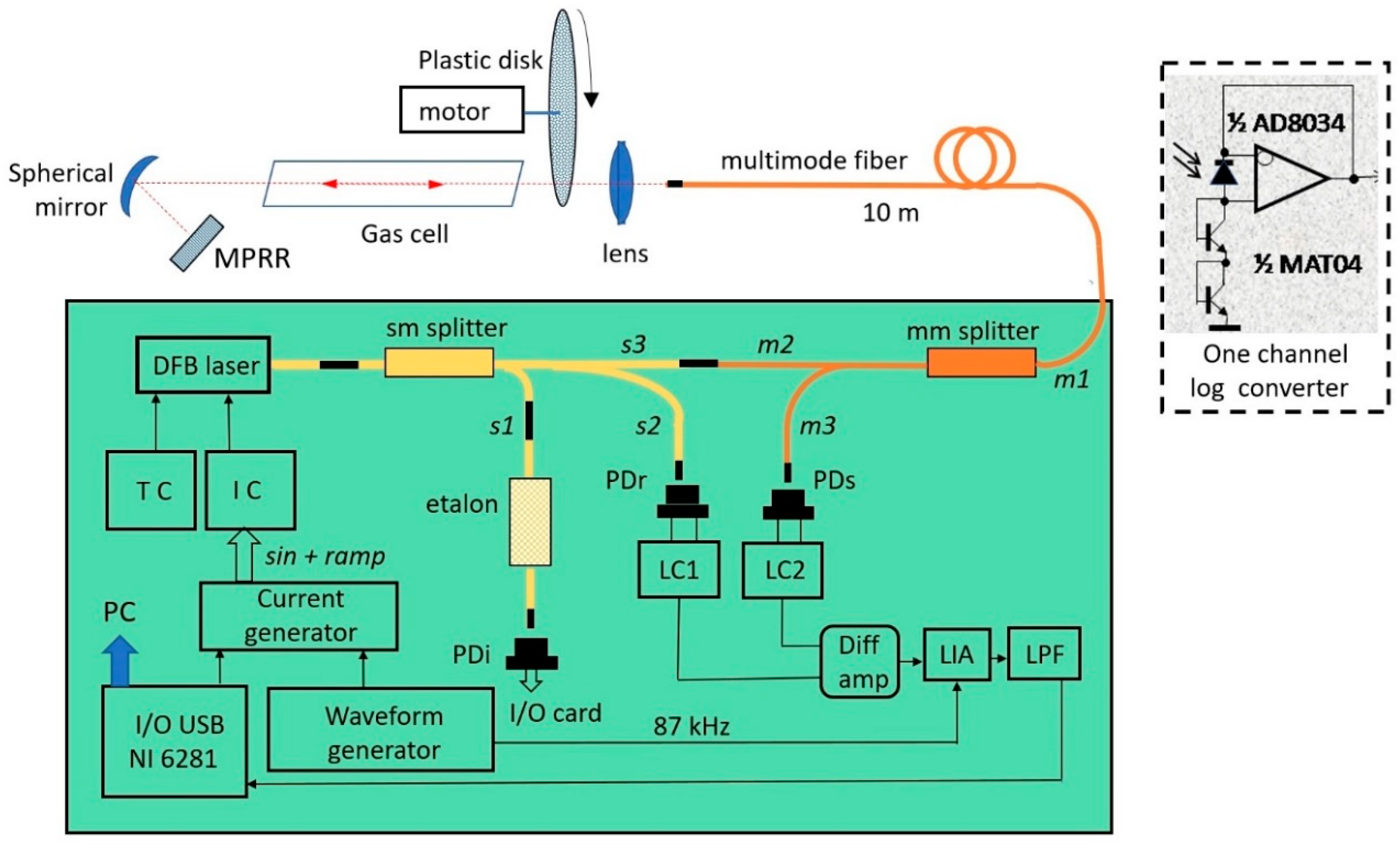
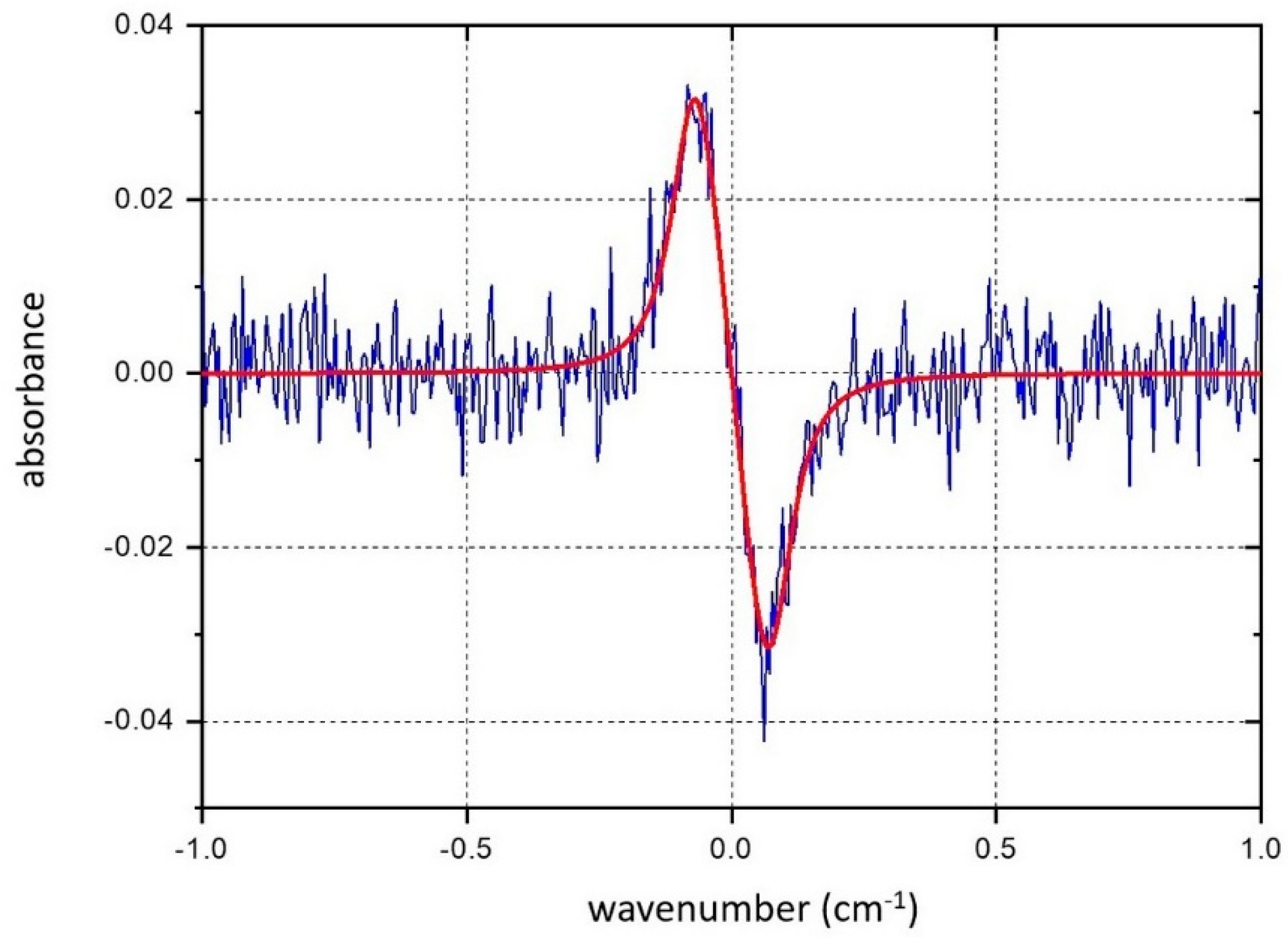
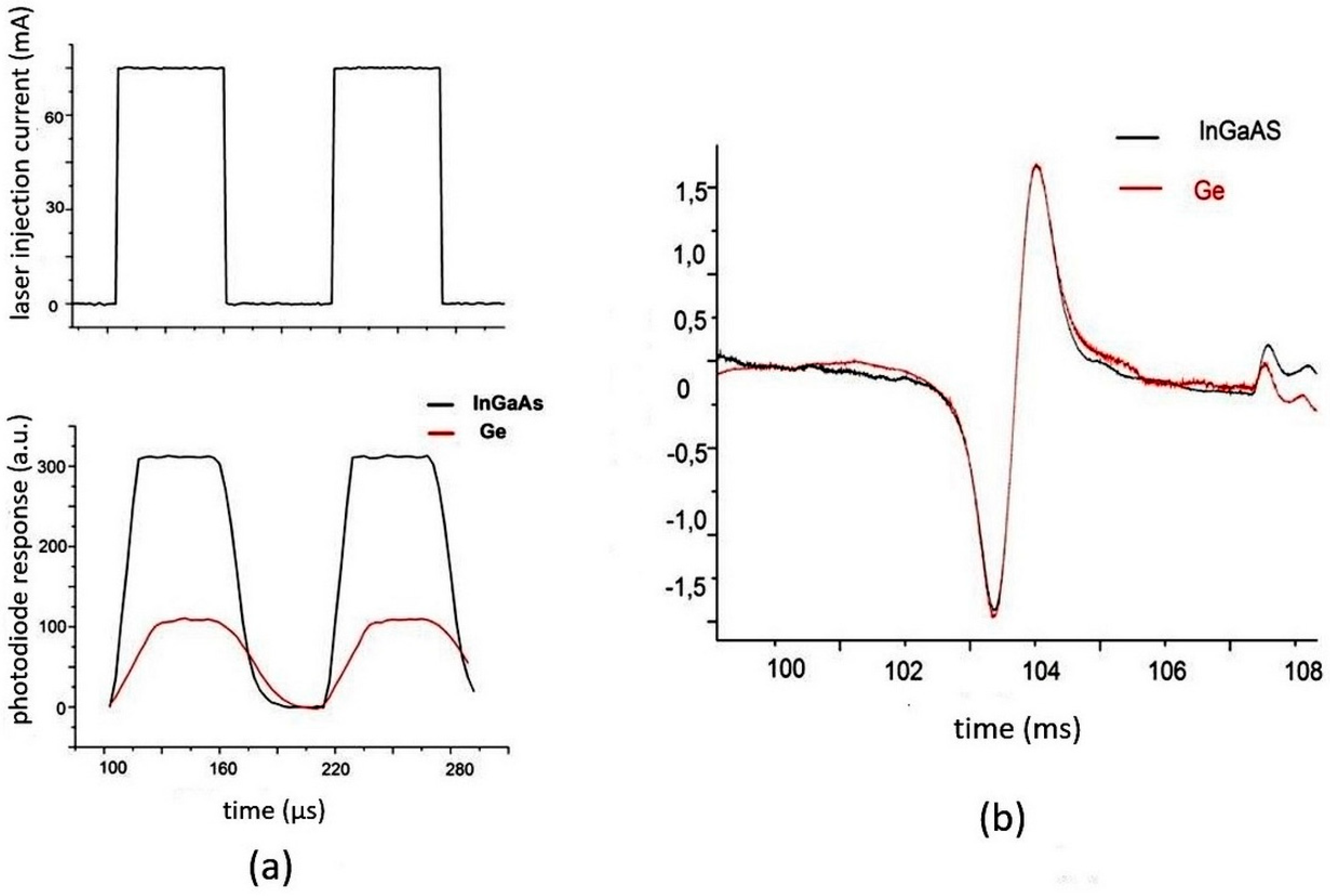
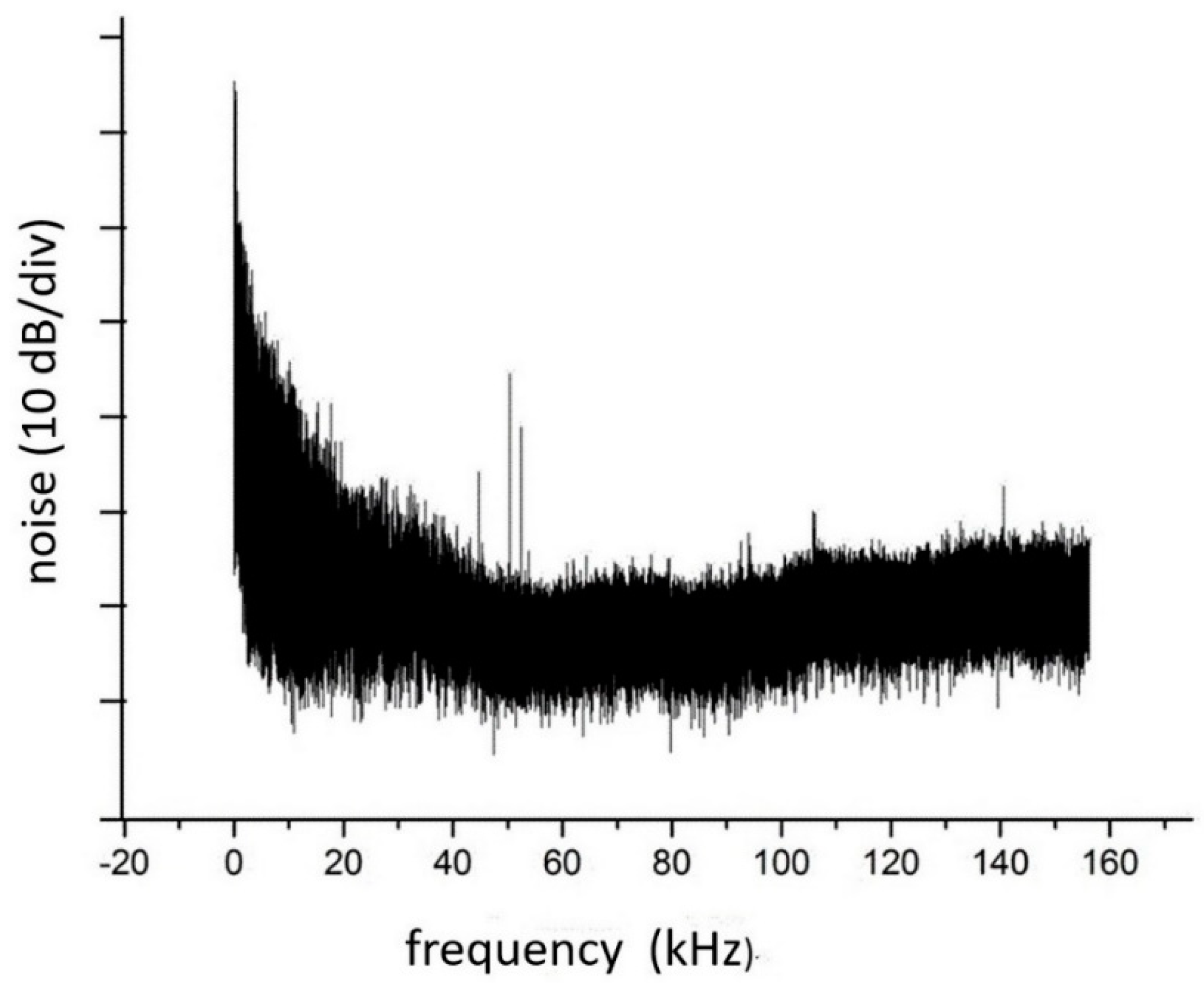




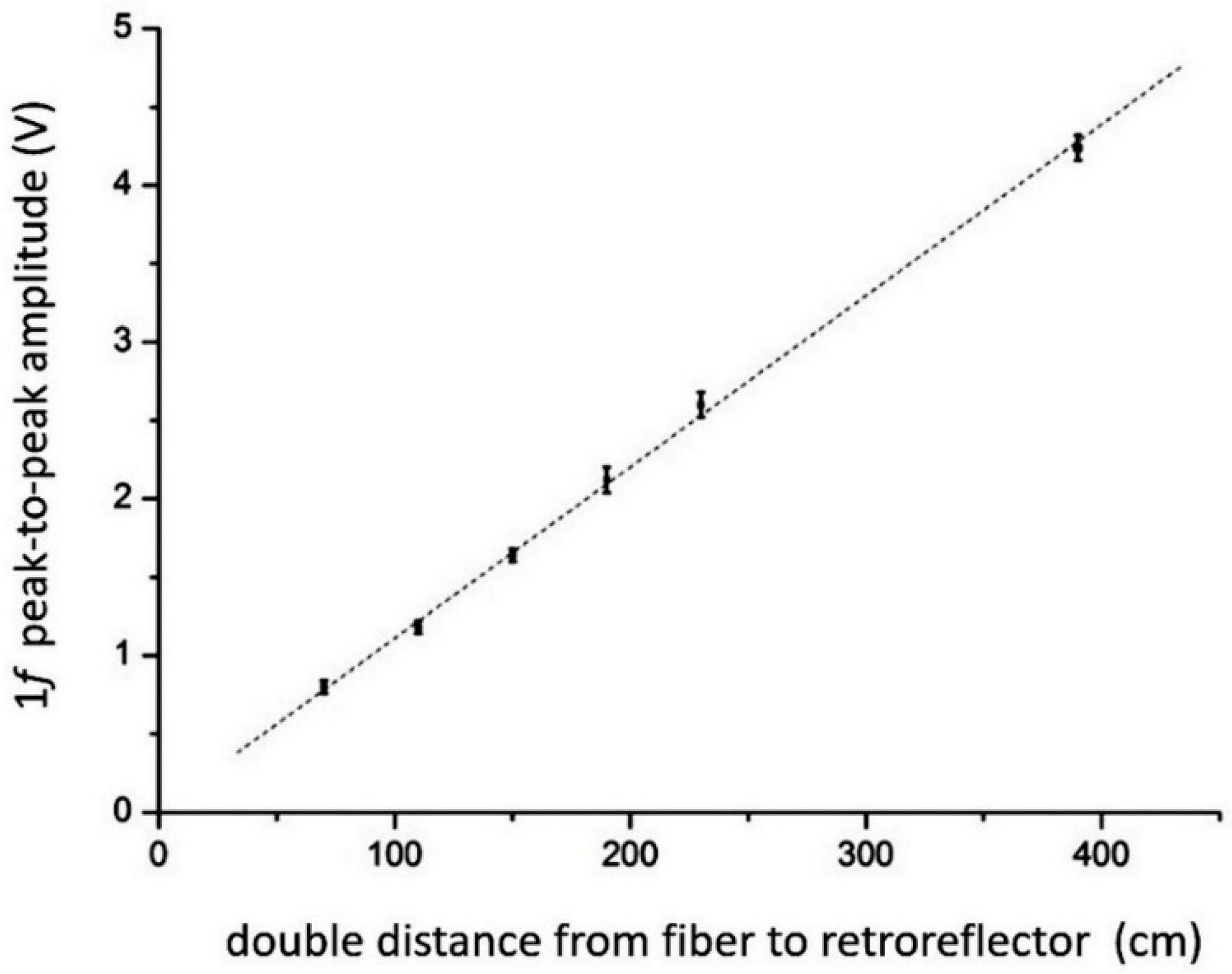
| A | σ(A) | am | σ(am) | δν0 | σ(δν0) | ΔνL | σ(ΔνL) | |
|---|---|---|---|---|---|---|---|---|
| 4 parameters were varied | 0.01011 | 0.000092 | 0.0792 | 0.00037 | –0.0001 | 0.00016 | 0.05016 | 0.00046 |
| am fixed | 0.00994 | 0.000062 | 0.08 | – | –0.0001 | 0.00015 | 0.0496 | 0.00034 |
| ΔνL fixed | 0.010037 | 0.000034 | 0.0795 | 0.00028 | –0.0001 | 0.00016 | 0.05 | – |
| am, ΔνL, δν0 were fixed | 0.009999 | 0.000031 | 0.08 | – | – | – | 0.05 | – |
Publisher’s Note: MDPI stays neutral with regard to jurisdictional claims in published maps and institutional affiliations. |
© 2020 by the authors. Licensee MDPI, Basel, Switzerland. This article is an open access article distributed under the terms and conditions of the Creative Commons Attribution (CC BY) license (http://creativecommons.org/licenses/by/4.0/).
Share and Cite
Liger, V.; Mironenko, V.; Kuritsyn, Y.; Bolshov, M. Advanced Fiber-Coupled Diode Laser Sensor for Calibration-Free 1f-WMS Determination of an Absorption Line Intensity. Sensors 2020, 20, 6286. https://doi.org/10.3390/s20216286
Liger V, Mironenko V, Kuritsyn Y, Bolshov M. Advanced Fiber-Coupled Diode Laser Sensor for Calibration-Free 1f-WMS Determination of an Absorption Line Intensity. Sensors. 2020; 20(21):6286. https://doi.org/10.3390/s20216286
Chicago/Turabian StyleLiger, Vladimir, Vladimir Mironenko, Yury Kuritsyn, and Mikhail Bolshov. 2020. "Advanced Fiber-Coupled Diode Laser Sensor for Calibration-Free 1f-WMS Determination of an Absorption Line Intensity" Sensors 20, no. 21: 6286. https://doi.org/10.3390/s20216286






